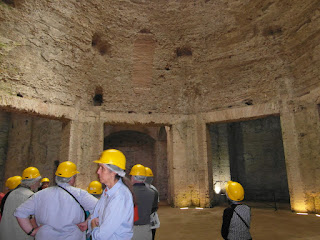The blog has been quiet for a few weeks as I've been away on holiday - a trip to Italy that included a stay in Rome and a memorable visit to the Domus Aurea, the Emperor Nero's 'Golden House'. Nero is legendary for his wild extravagance, depraved cruelty and appalling relations. He was reputed to have fiddled while Rome burned in 64 AD; a story that doesn't stand up to examination as violins hadn't been invented in Ancient Roman times, but he certainly did nothing to help his stricken subjects.
Instead, he razed what remained of the buildings on parts of the Esquiline, Caelian and Palatine Hills and built a gigantic palace where he held luxurious entertainments. Archaeologists are still excavating the Domus Aurea and no one is sure exactly how big it was but what has already been uncovered is vast. Its decoration shows that the palace would have outshone anything else of its time and much that came afterwards. Walls were covered with expensive marbles in a multitude of shades; with gold leaf and even with precious stones. The entrance hall was arranged so that rose petals would fall from the ceiling to greet guests, whose senses were also beguiled by perfume shot into the air from invisible sources. The dining room floor revolved so that all the dinners could enjoy the magnificent views from the windows.
The grounds were equally vast, embellished with many fountains fed by water drawn from the hills around and a huge artificial lake. There were also hunting grounds and a private collection of exotic animals from across the Empire.
The palace seems, however, to have had no bedrooms or permanent kitchens and it's believed Nero only used it for entertainment while still living in his old palace on the Quirinal Hill.
When the Romans finally had enough of Nero and forced him to commit suicide, his successor, Vespasian, drained the lake and built the Colosseum in it's place. A later Emperor, Trajan, built public baths over the palace, using it as foundations.
The Domus Aurea became a fading memory until Renaissance times when a young man crossing the site slipped into a crack in the ground. He found he had entered a magical world from antiquity.
He was followed by many curious visitors, including Renaissance artists such as Raphael, all of whom were prepared to risk life and limb in their eagerness to see what remained of the fabled palace and its artwork.
The task of unearthing the Domus Aurea has many more years to go but it was a great privilege to see how far the project has progressed.





No comments:
Post a Comment